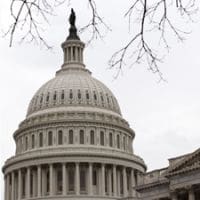According to the Bureau of Labor Statistics, the economy added 155,000 jobs during the month of December and an average of 151,000 jobs over the prior three months. The pace of job creation has been remarkably steady for two years—job gains averaged 153,000 per month in both 2011 and 2012. This rate of job creation has gradually chipped away at the unemployment rate, which was unchanged at 7.8 percent in December and has now been below 8 percent for four months. (These figures do not reflect the anticipated annual revision to the payroll data, which will be official in February and is expected to show that the level of employment was about 386,000 jobs higher in March 2012 than previously reported.)
This week marked the passage of the American Taxpayer Relief Act, which averted many of the tax increases and spending cuts that made up the so-called fiscal cliff. By passing that bill, policymakers avoided most of the near-term drag on the economy that would have occurred in the absence of an agreement. In the process, the Act reduced the projected budget deficit over the next decade by 7 percent from $10 trillion to $9.3 trillion.
In this month’s employment analysis, The Hamilton Project explores the projected impacts of the American Taxpayer Relief Act on economic growth and discusses the challenges still ahead with regard to the nation’s long-run deficit. We also continue to explore the “jobs gap,” or the number of jobs that the U.S. economy needs to create in order to return to pre-recession employment levels.
The American Taxpayer Relief Act and the Deficit Outlook
In last month’s employment analysis, The Hamilton Project studied the employment effects of the fiscal cliff, a set of federally legislated tax increases and spending cuts that were scheduled to take effect at the beginning of 2013. The policies that made up the cliff included the expiration of measures aimed at addressing the economic downturn, the expiration of Bush-era tax rates, and the onset of automatic budget cuts. This sudden reduction in government expenditures and spike in taxes could have badly damaged the fragile economy and, according to the Congressional Budget Office (CBO), would have reduced employment by 3.4 million jobs.
As 2012 came to an end, policymakers passed legislation that averted the worst projected impacts of the fiscal cliff on the economy. Income-tax cuts were extended for almost all taxpayers; the Alternative Minimum Tax was permanently patched; emergency unemployment insurance benefits were extended for a year; scheduled cuts to Medicare payments to doctors were averted; and the large automatic cuts in discretionary spending that were scheduled to take place at the beginning of 2013 were delayed by two months. All in all, these changes may have averted roughly 2.6 million of the 3.4 million job losses projected from going over the fiscal cliff.
The immediate budgetary impact of the American Taxpayer Relief Act is an approximately 7 percent reduction in the 10-year deficit. To arrive at this estimate, we contrasted the new legislation with the CBO’s alternative fiscal scenario, which includes a full extension of Bush-era tax rates and an indefinite postponement of the mandated spending cuts scheduled for 2013. According to the CBO’s latest budget outlook, under the alternative fiscal scenario, the nation faced a 10-year budget deficit of about $10 trillion. CBO scoring indicates that the American Taxpayer Relief Act will reduce the budget deficit by a little more than $700 billion over the next decade relative to that scenario. The figure below plots budget deficits under the alternative fiscal scenario before and after the American Taxpayer Relief Act for the coming decade. Despite the modest reduction in deficits under the new law, the debt-to-GDP level is still projected to increase for the foreseeable future.

The textbook solution to the dual problems of continuing near-term economic weakness and long-run budget deficits is to pair short-run economic stimulus with gradual but credible changes to spending and taxes that reduce deficits in the long run. By avoiding some parts of the fiscal cliff today, the American Taxpayer Relief Act is supportive of the first pillar. But much work remains to be done on part two—addressing the longer-run budget challenge. In the coming months, the task for policymakers is to achieve deficit reduction in the long run without drastically cutting essential services or damaging a recovering economy in the short run. This will not be easy from either a political or policy perspective and will require innovative proposals and solutions.
The December Jobs Gap
As of December, our nation faces a “jobs gap” of 11.0 million jobs. The chart below shows how the jobs gap has evolved since the start of the Great Recession in December 2007, and how long it will take to close under different assumptions of job growth. The solid line shows the net number of jobs lost since the Great Recession began. The broken lines track how long it will take to close the jobs gap under alternative assumptions about the rate of job creation going forward.
If the economy adds about 208,000 jobs per month, which was the average monthly rate for the best year of job creation in the 2000s, then it will take until August 2020 to close the jobs gap. Given a more optimistic rate of 321,000 jobs per month, which was the average monthly rate of the best year of job creation in the 1990s, the economy will reach pre-recession employment levels by January 2017. Again, these figures do not reflect the anticipated update to the payroll data due in February, which may reduce the actual jobs gap. You can also try out our interactive jobs gap calculator by clicking here and view the jobs gap chart for each state here.
Conclusion
Compared to going over the fiscal cliff, the American Taxpayer Relief Act will be beneficial for our economic recovery. But the United States still faces a daunting long-run budget outlook, and when policymakers return to Washington this month, they will face a host of budget challenges, including the rapidly approaching debt ceiling.
The Hamilton Project will host a two-part budget event in February that will present innovative policy options that help forge a path forward as the country’s leaders grapple with these longer-run challenges. The first in the series will be held on February 22nd and will focus on ways to create greater efficiency in our nation’s defense budget. Retired Admiral Gary Roughead, former Chief of Naval Operations, and Cindy Williams, former CBO Assistant Director, will present proposals for streamlining the military budget. The second event, on February 26th, will feature the release of fourteen targeted policy proposals for rethinking entitlement spending, tax reform, and how to create new sources of revenue and efficiency. Economists from around the country are participating in this broader discussion, bringing a diversity of perspectives from academia and the private sector, in addition to a range of political views. More information on The Hamilton Project budget events will be available in the near future.




